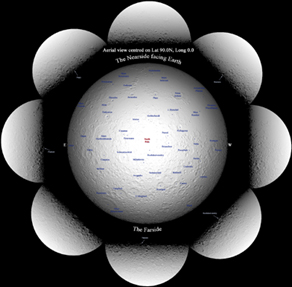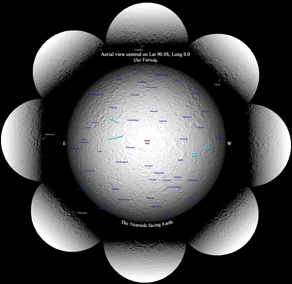Phases
Contents
[hide]The Moon's Phases
(glossary entry -- see also phase)
Description
The Moon's traditional phases are New, First Quarter, Full, and Last Quarter. To the layman these are simply reasonably apt descriptions of the Moon's changing appearance in the sky. To the astronomer they are technical time-keeping terms defining the moments at which the Moon's reaches precise points in its orbit.
Additional Information
- The technical definitions of the Moon's primary phases are based on the difference in ecliptic longitude (the rotational angle in the plane of the solar system objects) between the Sun and Moon as measured by an imaginary observer at the Earth's center. The Moon is New when the difference in ecliptic longitude is zero; it is at First Quarter when the difference is 90°; Full when the difference is 180°; and at Last Quarter when the difference is 270°. - Jim Mosher
- Note that since these are time definitions, a particular phase occurs at the same moment for all observers, but because of the effects of perspective each observer will see the Moon differently (and hence with slightly different amounts of illumination). The amount of illumination they actually observe is described (somewhat confusingly) by the similar-sounding technical term phase which refers to the percent illumination. - Jim Mosher
- The Moon is roughly 0% illuminated when New, 50% illuminated at the Quarters, and 100% illuminated when Full; but even for a geocentric observer these values are not exact, and they vary from month to month. - Jim Mosher
- At least in the English-speaking world, the definitive source for predictions of the dates and times of the Lunar Phases is the The Astronomical Almanac, published jointly by U. S. Nautical Almanac Office in the United States and Her Majesty's Nautical Almanac Office in the United Kingdom. The tables of the Primary Lunar Phases are freely available online, as is their explanation of what they believe is the correct terminology for the phases. - Jim Mosher
- Contrary to the terminology recommended in the The Astronomical Almanac, the Last Quarter is called, by some, the Second Quarter or Third Quarter. - Jim Mosher
- Part of the confusion -- and occasional controversy -- about the "correct" lunar phase terminology arises from the fact that many of the terms can be used to describe three distinct concepts: (1) a precise moment in the lunar cycle; (2) an extended interval in the lunar cycle; and (3) the appearance of the Moon as an object viewed in the sky.
- For example "First Quarter" can mean (1) the instant when the Moon is 90 deg from the Sun in ecliptic longitude; (2) the first quarter of the lunar cycle, which is an interval of roughly seven days beginning at New and ending at the First Quarter Moon of Definition 1; or (3) an observed Moon that is roughly 50% illuminated on the Mare Crisium side.
- Similarly "New Moon" can mean the astronomer's New Moon (a type 1 definition); an interval of a few days around the astronomer's New Moon (a type 2 definition); an interval of a few days after the astronomer's New Moon (an alternative type 2 definition); the first crescent Moon observed after the astronomer's New Moon (a type 3 definition); or, any young crescent Moon observed during the first few days after the astronomer's New Moon (an alternative type 3 definition). In this particular case, the latter two definitions of "New Moon" -- regarding it as a description of an object seen in the sky signifying that a new lunar cycle had begun -- appear to have a longer history than the other two. Whether its earliest usage meant the first-sighted young crescent or any young crescent is unclear, but in any event the astronomers appear to have appropriated a traditional expression and given it a slightly new meaning.
- The definitions given above, in terms of ecliptic longitude, are of "type 1": they define instants in the lunar cycle.
- Recently, there have been a number of claims on the internet that the astronomer's term New Moon is a confusing new invention for something that was traditionally called Dark Moon. These claims appear to be unfounded.
- AS09-23-3500 is an interesting photograph of the Last Quarter Moon, "snap-shotted" during the mission of Apollo 9 (March 1969). Apollo 9 was an Earth-orbiting mission, to test the first manned Lunar Module in space (LM Spider). Research Danny Caes.
- AS09-20-3058 is one of Apollo 9's few orbital photographs of the Waning Gibbous Moon', which is seen in the distance, a little above and to the right of LM Spiders nozzle cluster. Research Danny Caes.
- AS09-20-3059 is another one of Apollo 9's photographs of the Waning Gibbous Moon (near the photograph's left margin). One of the legs of LM Spider is seen below the photograph's centre. Research Danny Caes.
- AS09-20-3066 is the third one of Apollo 9's photographs of the Waning Gibbous Moon (visible just "right" of LM Spider). Research Danny Caes.
- See also: Saber's Beads, which is a curious optical phenomenon related to the very young (and thin) moon's crescent, or the very old (immediately after and/or before New Moon).- DannyCaes Mar 3, 2009
Phase Views
The following images and videos were created from the Kaguya/Selene DEM -- Digital Elevation Model -- data (see Jim Mosher's 'Obtaining Kaguya DEM Data' page for more). As phases of the Moon are usually associated with the 'Nearside' perspective by an observer standing on Earth, the additional phase-view options below are included merely as an experiment to see how the Moon looks from these view-points (the whole of the Moon does, after all, experience such phases as it orbits around Earth). - JohnMoore2 JohnMoore2
- Note: In these animations the Moon is treated as if it were a white plaster relief model, without its characteristic albedo markings. This gives a fairly realistic view of the pattern of light and shadow that would be seen at the terminator; but is not true to life for areas far from it. For example, in reality when the Moon is viewed from any angle at which it appears fully illuminated, the retro-reflective properties of the lunar surface material will cause the shadows to disappear and the disk will assume a flat appearance dominated by the albedo variations, especially the maria and rays -- a subtlety that is not included in the height data of the Kaguya DEM.
Aerial view centred on Lat 0.0, Long 0.0 (Nearside View)
| Image: Click image for larger view (to return to same page afterwards, use your back button). | |
| |
Video: For full screen view: (1) Click the play button. (2) While the movie is running, right-click on the image, goto zoom, click on full-screen (it will return to normal view after finishing). NB. Depending on your system, video may take several seconds to start. If you require to save the movie (Windows Video Media format) on your computer, go HERE to download. |
Aerial view centred on Lat 0.0, Long 180.0E (Farside View)
| Image: Click image for larger view (to return to same page afterwards, use your back button). | |
| |
Video: For full screen view: (1) Click the play button. (2) While the movie is running, right-click on the image, goto zoom, click on full-screen (it will return to normal view after finishing). NB. Depending on your system, video may take several seconds to start. If you require to save the movie (Windows Video Media format) on your computer, go HERE to download. |
Aerial view centred on Lat 0.0, Long 90.0E (Eastern View)
| Image: Click image for larger view (to return to same page afterwards, use your back button). | |
| |
Video: For full screen view: (1) Click the play button. (2) While the movie is running, right-click on the image, goto zoom, click on full-screen (it will return to normal view after finishing). NB. Depending on your system, video may take several seconds to start. If you require to save the movie (Windows Video Media format) on your computer, go HERE to download. |
Aerial view centred on Lat 0.0, Long 270.0E (Western View)
| Image: Click image for larger view (to return to same page afterwards, use your back button). | |
| |
Video: For full screen view: (1) Click the play button. (2) While the movie is running, right-click on the image, goto zoom, click on full-screen (it will return to normal view after finishing). NB. Depending on your system, video may take several seconds to start. If you require to save the movie (Windows Video Media format) on your computer, go HERE to download. |
Aerial view centred on Lat 90.0N, Long 0.0 (North Pole View)
| Image: Click image for larger view (to return to same page afterwards, use your back button). | |
| |
Video: For full screen view: (1) Click the play button. (2) While the movie is running, right-click on the image, goto zoom, click on full-screen (it will return to normal view after finishing). NB. Depending on your system, video may take several seconds to start. If you require to save the movie (Windows Video Media format) on your computer, go HERE to download. |
Aerial view centred on Lat 90.0S, Long 0.0 (South Pole View)
| Image: Click image for larger view (to return to same page afterwards, use your back button). | |
| |
Video: For full screen view: (1) Click the play button. (2) While the movie is running, right-click on the image, goto zoom, click on full-screen (it will return to normal view after finishing). NB. Depending on your system, video may take several seconds to start. If you require to save the movie (Windows Video Media format) on your computer, go HERE to download. |
LPOD Articles
Half a Golden Quarter (a wonderful and detailed drawing of the Last Quarter Moon's northern half, by Joseph Klepesta and Ladislav Lukes)
Where is that Moon?
Bibliography
- Seidelmann, P. Kenneth. 2005. Explanatory Supplement to the Astronomical Almanac: A Revision to the Explanatory Supplement to the Astronomical Ephemeris and the American Ephemeris and Nautical Almanac. University Science Books (same as 1992 hardcover edition). See Google books: p. 478 for definitions of principal phases of the Moon.





